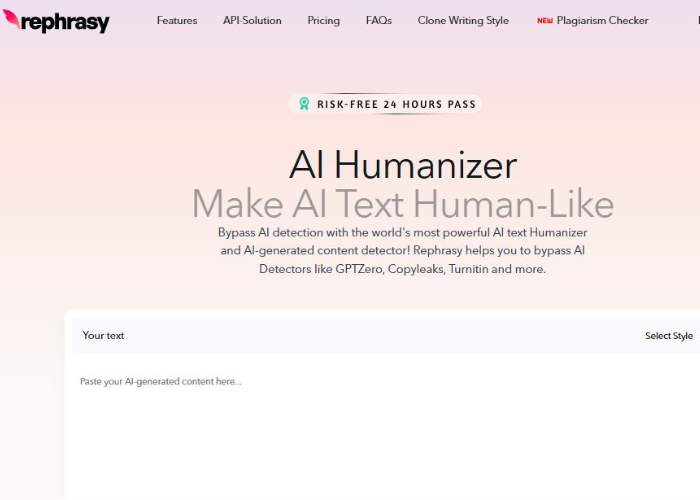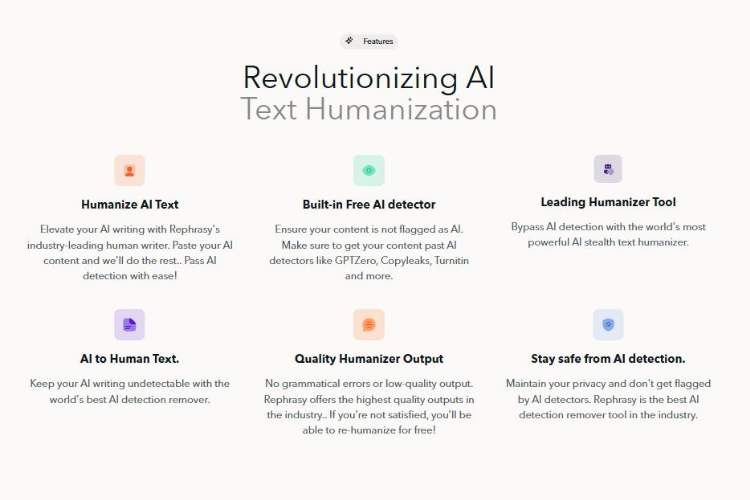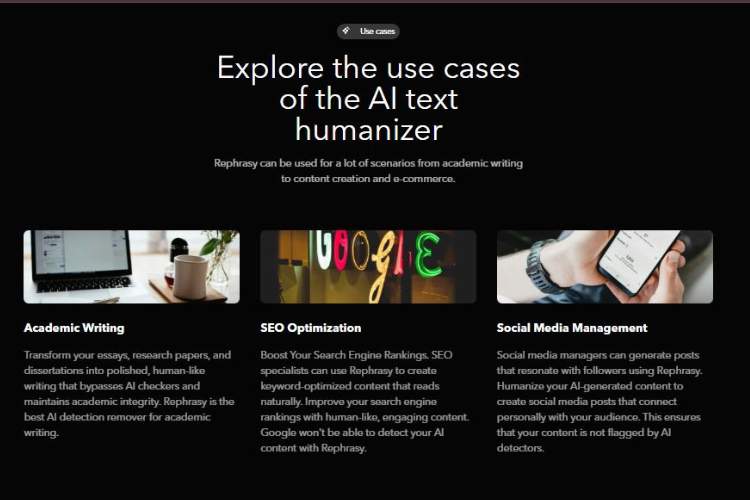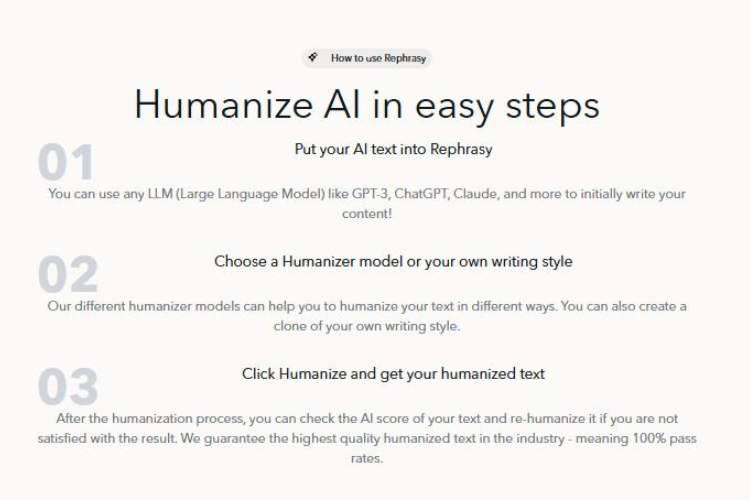I wanted to know, honestly and without theatrics: does Rephrasy do what it claims—detect AI writing and humanize AI text enough to slide under common detectors—without mangling meaning or tone?
The pitch is glossy: a built-in AI detector, one-click “humanization,” style cloning, a plagiarism checker, even “bypass” pages that promise high success rates against GPTZero and Copyleaks. That’s a big, risky promise in 2025.
I spent time pasting drafts (my own messy paragraphs, clean LLM outputs, and hybrid edits) into Rephrasy, then cross-checking with third-party detectors.
I also read a handful of independent takes—some positive, some unimpressed—because tools in this space love to market themselves as “undetectable,” and the reality is always fuzzier.
Spoiler: there’s a gap between the landing-page swagger and day-to-day reliability, though not everything is smoke and mirrors.
What Rephrasy Says It Is (and the parts I actually used)
Rephrasy positions itself as a two-in-one: an AI detector and a “humanizer” that rewrites AI text to look more human while “preserving meaning.” There’s a simple editor, a style selector, and buttons to “Check AI Score” or “Humanize.”
The site lists multi-language support, a Chrome extension, style cloning, and API options; there are also tutorial pages and specific “bypass” hubs claiming 97–98% success for Copyleaks/GPTZero after humanization (the demo boxes show dramatic “before vs after” probabilities).
In practice, I appreciated the friction-free UI—paste, choose a style, click—but I stayed skeptical of success-rate claims until I tested.
Two conceptual flags worth naming up front:
- Dual purpose = dual incentives. When a product sells both “detection” and “bypass,” there’s a built-in tension. A detector should be conservative, while a humanizer markets aggressiveness. I tried not to judge the ethics here—publishers/educators will—but it’s good to be aware of the design tradeoffs.
- Detector generalization. Vendor-hosted detectors (including Rephrasy’s) tend to overfit to the distribution they know. Independent reviewers have pointed out weaknesses in Rephrasy’s built-in checker; I saw some of that too when I compared scores to outside tools.
Hands-On: Accuracy, Humanization Quality, and Where It Trips
1) Built-in AI Detector (mixed confidence)
On straightforward, raw LLM passages, Rephrasy’s detector usually called it AI (good). On my human text—messy syntax, idioms, varied sentence lengths—it leaned human (also good). But on hybrid text (AI paragraphs that I heavily edited), verdicts wobbled.
That’s not unique to Rephrasy; hybrid content is hard for most detectors. Still, third-party reviewers have argued Rephrasy’s detector is comparatively weak, and I get why: it sometimes under-scores polished human writing and over-scores concise technical prose. If you need a single arbiter of “AI or not,” I wouldn’t rely solely on this meter.
2) Humanizer Output (usable, but variable)
On simple expository AI text, the humanizer did a decent job: it injected burstiness, shifted diction, and broke up rhythm without absurd synonym swaps.
On nuanced prose, results were spottier—occasional over-paraphrasing, slightly off idioms, and the rare sentence that read like a stitched quilt. That said, the “keep meaning” claim was mostly fair on my tests; semantic drift happened, but not constantly.
External takes are divided: some bloggers rate it poorly against top competitors, while others call it workable if you polish after. I land in the middle—fine for first-pass de-robotizing, not a final draft.
3) “Bypass” Promises (treat as marketing, not guarantees)
Rephrasy’s GPTZero/Copyleaks pages tout post-humanization success rates around ~97–98%. In my cross-checks, some passages did slip past one detector and then got caught by another—and sometimes got caught by the same detector after a trivial re-scan.
That’s the reality in 2025: detector behavior is unstable across versions, training sets, and thresholds. So yes, humanization can lower AI-likelihood scores and sometimes pass a given tool; no, it doesn’t confer magical invisibility.
The product pages themselves are careful to show examples rather than audited studies, so use your judgment.
The Good Stuff (why I didn’t just close the tab)
- Fast, simple workflow. If you’ve ever bounced between a paraphraser and a separate AI checker, the one-screen flow is undeniably convenient. The UI is minimal and quick.
- Feature breadth. Tutorials, API talk, style cloning, multi-language notes, and a plagiarism checker make it feel like a small suite rather than a single trick. Even if you won’t use everything, it’s nice to see the ambition.
- Reasonable first-pass edits. For bland, “AI-smooth” drafts, the humanizer introduces natural variation without butchering meaning most of the time. That’s useful as a starting point even if you plan to revise by hand. (This aligns with the general pattern that premium humanizers can outperform free ones on consistency, though “premium > free” isn’t unique to Rephrasy.)
The Rough Edges (and some realities no tool can dodge)
- Detector trust gap. Independent reviewers have criticized Rephrasy’s built-in detector; my experience didn’t fully restore that trust. If detection fidelity matters, validate with third-party checkers (and human review).
- Marketing vs. measurable guarantees. “98% success” headlines are clickable, but your mileage will vary by text domain, length, and the specific detector/version you test against tomorrow versus today. That’s not shade; it’s the state of the arms race.
- Community skepticism. You’ll find Reddit and blog threads where power users call the humanizer mid or “terrible”; you’ll also find pro-Rephrasy blog posts (some obviously promotional). The split underscores how context-dependent results are.
Price/Value Lens (who actually benefits)
If you’re a solo writer or marketer who wants a quick way to rough-up sterile AI prose before your own editing pass, Rephrasy’s convenience is the main value prop.
If you’re an educator, editor, or publisher hoping for a reliable truth machine, you’ll want diverse signals: multiple detectors, stylistic analysis, and—most importantly—editorial judgment.
For developers/ops thinking about workflow scale, the API talk is interesting, but I’d benchmark output quality and latency against peers before committing.
Ethics & Practical Advice (the human part)
I won’t moralize. People use “humanizers” for many reasons: smoothing awkward AI scaffolds, protecting privacy, or, yes, trying to sneak past institutional gates. My advice is simple and pragmatic:
- Don’t outsource voice. Use tools like this to break the AI sheen, then bring your own lived texture back: add specific memories, numbers you actually checked, your own metaphors.
- Assume detectors evolve. Even if a passage “passes” today, a later scan or a different tool may flag it. Don’t hinge reputations—or grades—on a single score.
- Keep receipts. Draft notes, sources, and revision history help you defend authorship if someone questions it.
That last point matters; the emotional sting of being wrongly flagged is real. Tools promise certainty. Real life is messier.
Bottom Line & Verdict
Rephrasy is a convenient, all-in-one “detect + humanize” workstation with a friendly UI and decent first-pass rewrites. For quick de-robotizing of generic AI prose, it’s fine. For high-stakes truth-finding—or for bulletproof “bypassing”—temper expectations.
External reviewers have raised legitimate criticisms about the built-in detector and overall consistency; my testing didn’t negate those concerns, though I did get usable outputs with some manual polish.
If you go in viewing Rephrasy as a drafting aid rather than an invisibility cloak, you’ll avoid most disappointment.
Would I keep it in my toolbox? As a pre-edit button to roughen AI gloss, yes. As a single source of detection truth, no. As a “one click and you’re undetectable” solution, also no—because that doesn’t really exist, and anyone promising it is selling comfort, not guarantees.
Sources & further reading
- Rephrasy homepage & features (detector + humanizer, multi-language, style cloning).
- “Bypass” pages and claimed post-humanization success examples (GPTZero/Copyleaks).
- Third-party summaries of features (Chrome extension, built-in detector, languages).
- Independent reviews critiquing effectiveness vs. competitors.
- Community chatter and mixed user experiences.
If you want, I can run a small side-by-side test plan next: pick one paragraph, pass it through Rephrasy and two competitor humanizers, then check the outputs against 3 popular detectors and grade readability. That gives you a concrete, apples-to-apples snapshot for your use case.




